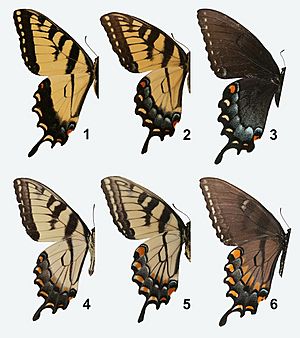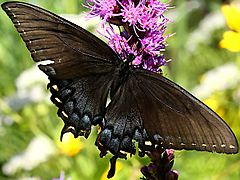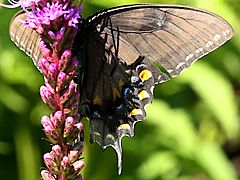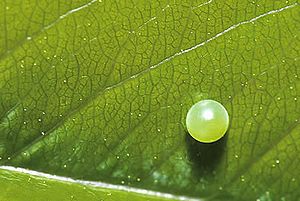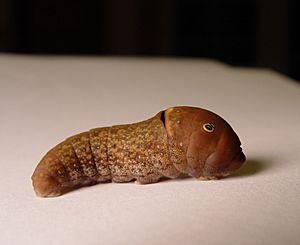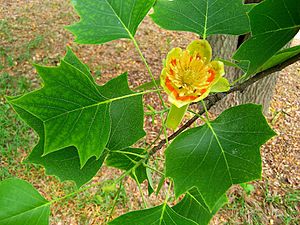Eastern tiger swallowtail facts for kids
Quick facts for kids Eastern tiger swallowtail |
|
|---|---|
 |
|
| Male | |
 |
|
| Female | |
| Conservation status | |
| Scientific classification | |
| Genus: |
Papilio
|
| Species: |
glaucus
|
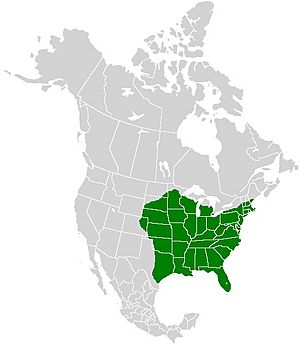 |
|
| Synonyms | |
|
|
The Papilio glaucus, also known as the eastern tiger swallowtail, is a beautiful butterfly found in eastern North America. It's one of the most well-known butterflies in the eastern United States. You can often spot it in many different places, from forests to gardens.
These butterflies fly from spring until fall. During this time, they have two or three groups of babies, called broods. Adult butterflies drink nectar from many kinds of flowers. Their wings can spread from about 7.9 to 14 centimeters (3 to 5.5 inches) wide.
Male eastern tiger swallowtails are bright yellow. They have four black "tiger stripes" on each of their front wings. Females can be either yellow or black. This means they have two different forms, which is called dimorphism. Yellow females look like the males. But they have a clear band of blue spots on their back wings. Dark females are almost completely black.
The female butterfly lays single green eggs. She places them on plants like the tulip tree or wild black cherry. Young caterpillars are brown and white. Older caterpillars turn green. They have two black, yellow, and blue spots that look like eyes on their body. Before turning into a chrysalis, the caterpillar becomes brown. It can grow up to 5.5 centimeters (2.2 inches) long. The chrysalis can be whitish or dark brown. If winters are cold, the butterfly will sleep through winter in this chrysalis stage.
The eastern tiger swallowtail is a special butterfly in many states. It is the state butterfly of Alabama, Delaware, Georgia, North Carolina, and South Carolina. It is also the state insect of Virginia.
Contents
What Does It Look Like?
Eastern tiger swallowtails have a wingspan from about 7.9 to 14 centimeters (3 to 5.5 inches). Females are usually bigger than males. Butterflies from southern areas are also larger than those from northern areas.
Males are yellow with four black "tiger stripes" on each front wing. The outer edge of the front wing is black. It has a row of yellow spots. The wing veins are marked with black lines. The back part of the hindwing is black. It has yellow spots along its edge. The inner edge of the hindwing has small red and blue spots. The underside of the front wing has a yellow bar. This bar is broken into spots. Both males and females have this broken bar. It helps tell P. glaucus apart from similar butterflies.
Female butterflies come in two forms. The yellow form has a blue area on the top of her hindwing. This blue area is not on the male. In the dark form, the parts that are usually yellow are dark gray or black. The blue area on the underside of the hindwing has one row of orange spots. You might still see a faint shadow of the "tiger stripes" on the underside of some dark females.
Where Do They Live?
You can find P. glaucus in the eastern United States. Their range goes from southern Vermont down to Florida. It stretches west to eastern Texas and the Great Plains. They are common in most of this area. However, they are less common in southern Florida. You won't find them in the Florida Keys.
These butterflies live almost anywhere there are forests with trees that lose their leaves. You can see them in woodlands, fields, near rivers and creeks, along roadsides, and in gardens. They even fly into city parks and yards. Because they can live in many different places and eat many different plants, they are not considered in danger.
Adult butterflies are seen from spring to fall. The exact dates depend on where they live. In the south, they fly from February to November. In the north, they fly from May to September. They have two groups of babies in the north. In the south, they have three groups. The first group of butterflies to hatch are usually the smallest.
How Do They Behave?

Eastern tiger swallowtails are active during the day. They usually fly alone. Adult butterflies often fly high above the ground. You might see them above the tops of trees. Males look for females by flying around areas where the caterpillars' food plants grow. During courtship, the male and female fly around each other. Then they land and mate. The male releases a perfume-like scent. This helps to attract the female to mate.
Adult butterflies eat from many different flowers. They often like strong plants with red or pink flowers. Many plants from the dogbane, daisy, and pea families are common food sources. Males often gather on mud, wet gravel, or puddles. This behavior is called "puddling." They get important salts and nutrients from these wet spots. These help them with reproduction. Males usually puddle when they are fresh, for their first few days. Females sometimes puddle, but they don't gather in groups. Adults have also been seen feeding on animal waste and dead animals.
The eastern tiger swallowtail eats more different types of plants than almost any other swallowtail butterfly in the world.
Life Cycle
The eastern tiger swallowtail can have one or two generations of butterflies in the north. In southern areas, they can have three generations. Here's how long each stage usually lasts:
- Egg: Eggs hatch in three to five days.
- Larva (Caterpillar): The caterpillar goes through five growth stages.
- Pupa (Chrysalis): This stage lasts nine to eleven days. If it's winter, it can last much longer.
Egg Stage
Female butterflies lay their eggs one by one. They place them on the leaves of their host plants. They prefer to lay eggs near flowers where they can get nectar. The egg is round and green. It later turns yellowish-green with small red dots. The egg is quite large for a butterfly egg. It is about 0.8 millimeters (0.03 inches) tall and 1.2 millimeters (0.05 inches) wide. It takes between 4 and 10 days for the egg to hatch.
Caterpillar Stage
The caterpillar eats the leaves of its host plant. It rests on a silk pad on a leaf. It folds the edges of the leaf over itself and holds them with silk. The first three stages of the caterpillar are brown. They have a large white spot on their back, which looks like a saddle.
After shedding its skin for the third time, the caterpillar turns green. Its body near the head looks swollen. It has two black, yellow, and blue spots that look like eyes. These eyespots are smaller than those on the similar-looking spicebush swallowtail caterpillar. There is a yellow and black stripe between the first and second body parts. This stripe is hidden when the caterpillar is resting. The rest of its body has light blue spots. Before it turns into a chrysalis, the caterpillar becomes dark brown. It can grow up to 5.5 centimeters (2.2 inches) long.
Chrysalis Stage
The chrysalis is about 3.2 centimeters (1.3 inches) long. It hangs from a surface. It uses a silk band around its middle and a silk pad at its base. The chrysalis can be different colors. It might be off-white or dark brown. It often has green and dark brown spots. Lighter chrysalises often have a dark stripe along each side. There are two horn-like bumps on its head. One bump is on its body.
You can find P. glaucus chrysalises in many places. They are often on tree trunks, fence posts, and in leaves on the ground. If the winter is cold, the butterfly will stay in its chrysalis until spring.
Host Plants
The caterpillar eats leaves from many different plant families. Common host plants are from the magnolia and rose families. These include the tulip tree (Liriodendron tulipifera), sweet bay magnolia (Magnolia virginiana), and wild black cherry (Prunus serotina). They also eat other plants from the rose family. Some caterpillars also eat plants from the laurel, olive, citrus, and linden families.
Some older books mention aspens, birches, and willows as host plants. However, these are mostly eaten by a different, but similar, butterfly called P. canadensis.
Here are some common host plants for P. glaucus:
- Wild black cherry (Prunus serotina)
- Ash trees (Fraxinus species)
- Cottonwood (Populus species)
- Wafer ash or hoptree (Ptelea trifoliata)
- Common lilac (Syringa vulgaris)
- Sweet bay magnolia (Magnolia virginiana)
- Tulip poplar or tulip tree (Liriodendron tulipifera)
- Willow (Salix species)
How Do They Protect Themselves?
When they are young, the first three stages of the caterpillar look like bird droppings. This helps them hide from birds and other animals that want to eat them. In later stages, the eyespots on their body help scare away birds.
Like all swallowtail caterpillars, the P. glaucus caterpillar has a special orange, fleshy organ called an osmeterium. When the caterpillar feels threatened, it pushes this organ out. It releases a bad-smelling liquid that scares away predators. This organ is usually hidden. The combination of the eyespots and the osmeterium makes the caterpillar look like a small snake.
Adult butterflies are tasty to predators. So, the dark female butterflies use a clever trick called Batesian mimicry. They look like the poisonous Pipevine swallowtail. This helps protect them from animals that have learned not to eat the pipevine swallowtail. Dark females are more common in the southern areas. This is where the pipevine swallowtail is also more common.
Images for kids



